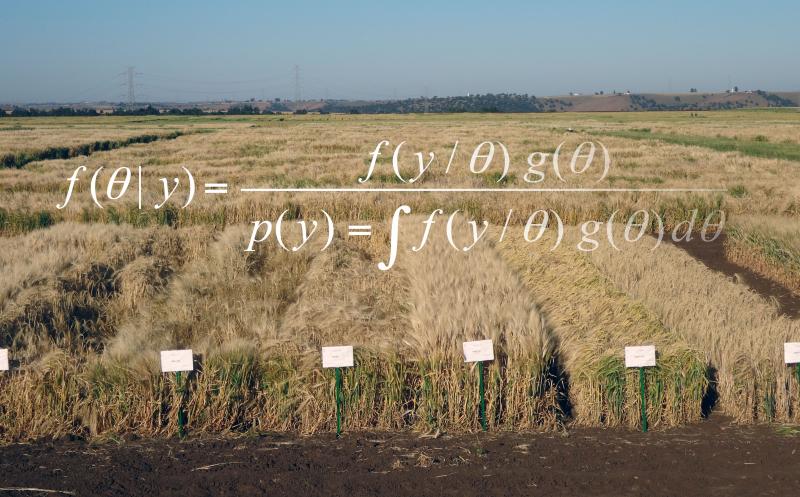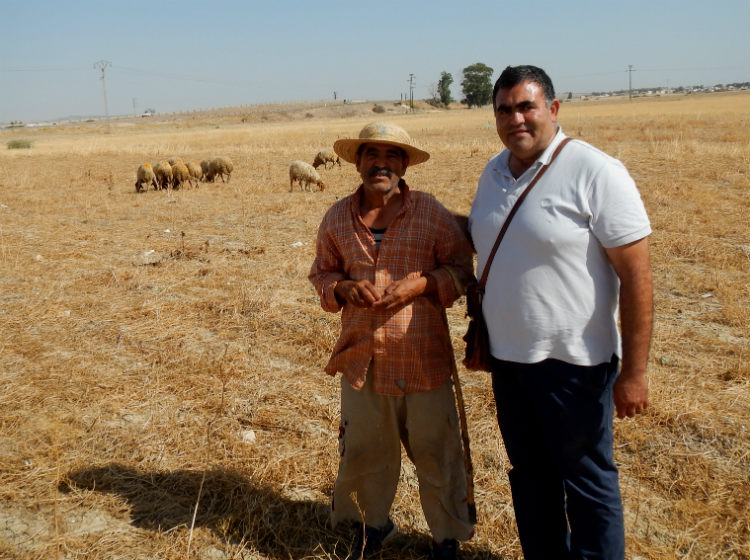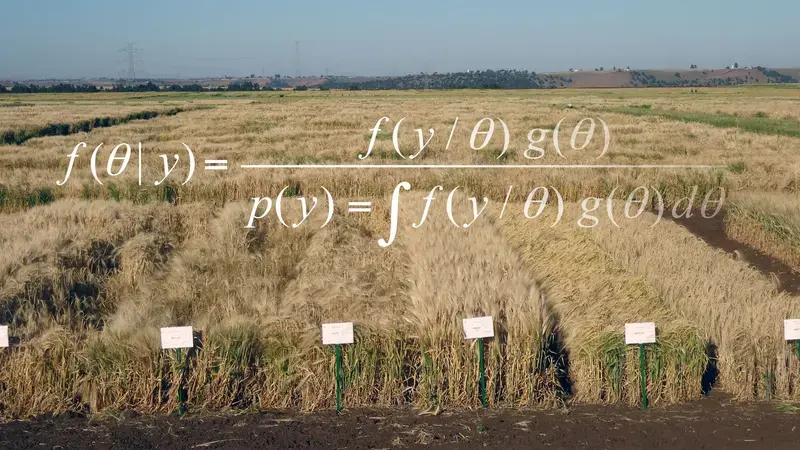In this issue
'Big Data' Spells Big News for Crop Breeding Programs

Imagine designing new drugs without utilizing the results from previous clinical trials. How efficient would be the process of finding a cure? This is somewhat close to what's happening in crop breeding programs today.
Developing improved crop varieties is a long journey for breeders - on an average lasting 10 years or even more. Regular evaluation of varieties are carried out in a series of designed field trials over multiple locations and years, continually rejecting some, retaining some and adding new varieties in search of the desired traits, generating volumes of data in the process. However, this wealth of data generated from prior routine trials lies unutilized. The normal breeding practice today is to use current trials, starting evaluations of genotypic materials anew.
Crop breeders could now have at hand an elegant solution that allows infusing empirical evidence into the iterative process of genetic selection - a more efficient approach to breeding improved crop varieties.
"We have applied a common mathematical analytical tool in a brand new context of crop breeding", explains Murari Singh, biometrics specialist at ICARDA, who has been working with crop researchers to develop a systematic framework that can harvest and harness existing data to refine the process of crop breeding.
The Bayesian framework uses probability distribution of various parameters to enrich the current information in identifying accessions' potential and predicting the genetic gain when certain genotypes are crossed to make progress toward desired traits - for example, high yielding wheat with drought tolerance. Using empirical evidence to inform the iterative process of selection of good lines and removal of bad lines is lending a firm footing to crop breeding.
"The benefit of adopting Bayesian framework is not in high precision of results but the gain in authenticity of the results. Building on existing results ensures more sound and robust basis for designing current trials", points out Singh.
The statistical framework was constructed using crop yield data on 30 barley genotypes developed at ICARDA as of 2011, and incorporating data from a series of 20 other previous trials. The methodology provides step-by-step procedure ready for application by crop breeding programs.
The adoption of the approach to mine 'big data' in crop breeding will progressively refine the statistical framework, putting crop breeding on a more well-grounded, evidence-based path.
The methodology is published in Crop Science Journal, December 2014, Vol. 55 No. 2 as an open access publication.
Supported by: Government of Italy, CGIAR Research Programs on Dryland Cereals and Dryland Systems
Revisiting Vetch with Farmers Promotes Zero-Till Practice
Integrated Livestock Solutions

Taoufiq Ben Ammar lives on one of the dales in Chouarnia (district of Siliana, Tunisia) and his livelihood is intrinsically linked to what he sells from wheat cropping, weaned lambs and a couple of dairy cows. He is one of 18 farmers in Chouarnia and Sned El Haddad localities where ICARDA and INRAT (the national agricultural research institute of Tunisia) have been collaborating for the past three years developing integrated crop-livestock solutions under an IFAD-funded Conservation Agriculture project in Tunisia, Algeria and Tajikistan.
Every year in late spring, farmers worry about the expected wheat yield. Many farmers have modest expectations for grain yield, despite an apparent good vegetative growth of the crops. Concerns remain about rain shortage during the months of April and May and its impact on grain filling and yield. Taoufiq says his fields are progressively being cropped under conservation agriculture and points to the savings in energy and mechanization costs that the cropping practices have generated. Now, they don't have to plough the land before seeding. Inside his barn are 300 well-stacked, finely cut and greeny vetch hay bales-- harvested in late April on only one ha, surprisingly high for a dry year. The vetch would be used to feed the growing lambs he wants to sell during Aid El Idha.
Salah Ben Youssef, Forage Specialist at INRAT noted that the vetch was introduced in the area as a substitute to cereal stubble grazing under a zero-till cropping package.
"Although it is an ancient crop widely grown in North Tunisia in the past, vetch is being rediscovered by the farmers in the region," said Ben Youssef.
"It is one of the technical options to address tradeoffs if farmers are to adhere to putting their land under conservation agriculture. The cropped area has been steadily increasing and now we are faced with the issue of seed availability at the start of every cropping season."
Jamel Sahli, another farmer in the neighborhood, expressed an interest in buying his harvest of vetch hay. Sahli was introduced vetch last year and decided to have it directly grazed in late spring early summer by his flock of ewes in the middle of the mating season. He observed that when the ewes were allowed to graze vetch, there was a "burst" in the frequency of females displaying estrus, in contrast to when the ewes were fed cereal stubble. The behavior is a manifestation of how nutrition affects reproduction in sheep.
What Sahli observed is likely associated with the effect of a brusque provision of high-quality nutriments from vetch on the reproductive axis of sheep. These observations can be assimilated to the classic "flushing effect" or the more recent concept of immediate nutrient supply commonly obtained by the distribution of moderate quantities (0.4 to 0.6 kg) of concentrate.
Vetch grazing can provide a synchronous provision of energy and protein which is highly beneficial to ovarian follicular growth and oocyte quality. Sahli is planning to use the same plot once again for his flock of ewes during the coming mating season.
"We plan to set-up a flock monitoring and data collection scheme this year to quantify the effect of vetch grazing on sheep reproduction by retrospectively assigning the lambing data (fertility and litter size) to the nature of the grazing material during mating time," says Mourad Rekik, small ruminant production scientist at ICARDA.
The results will feed into better integration of crop-livestock systems and further scaling out of zero-till package amongst the farmers.
Supported by: IFAD and implemented within the framework of CGIAR Research Program on Dryland Systems
Digging Dirt with a Budding Soil Scientist

Mouna Mechri lives in Tunisia and is completing her last year of PhD on agronomy. Recently, she was selected for training under the Young Agricultural Scientists Program (YASP), a component of the "Enhancing Food Security in Arab Countries" project.
Q. What topic did you choose to work on for your research?
I am studying the formation of organic matter of the soil in different cropping systems and in different regions of Tunisia. Through the YASP training, I learnt more about the biological nitrogen fixation from sowing legumes in cereal-based cropping systems and how that improves soil quality and yields.
Q. Kids often dream of being an astronaut, musician, teacher, etc. How did you come to be a soil scientist?
When I was in school, I actually wanted to be a journalist. But all my family and close friends encouraged me to become an agronomic engineer as my father is a farmer.I am happy now because I am working in a field that really makes me feel satisfied.With PhD, I can work in national and international organizations where I can learn more and improve my knowledge. I have many research questions in my mind and hope to answer them.
Q. The Young Agricultural Scientist Program is aiming to foster young scientists like yourself. What did you enjoy the most about it?
I had heard about the program from its national coordinator in Tunisia and I was very excited when my research proposal got accepted. I was able to learn new skills and got to know an international organization which can help me and my country to develop new research programs. Also I was excited to meet and learn from famous researchers that I never thought I could meet face to face.
Q. You could have chosen many topics in agriculture. Why soil?
Of course, I can choose many other topics, but I don't choose them because soil covers all!I wish to tell you a lovely story with my professor. He said, if the soil were to be a human being, it should be your close friend. Moreover, the study of organic matter of soil is poorly covered in Tunisia. Organic matter has important parameters that influence the characteristics of the soil and can determine the productivity - this is much needed in the semi-arid regions of Tunisia.
Q. 2015 is the International Year of Soils. Did you get to participate in any special activities?
Yes, I know about this and have an ambitious idea with my colleagues - we would like to create a soil and environment society which will work with scientists, farmers and new generation to create a new mentality of environmental preservation and sustainable development. I hope we are able to develop it.
Q. Women play a big role in farming in many countries and can contribute a lot if they are given the technical skills. What is the role of women in Tunisia?
In my country, women are involved in a wide range of activities - in irrigation, animal breeding, plowing, and planting. Since the woman deals with different resources, it is important for her to be sensitized and well-informed on sustainable ways to manage our natural resources. This can prevent deterioration and abuse of water, forests and soil. Also women are mothers and I think, they can help raise awareness of future generations about the natural resources, so they can have a life of dignity.
The Young Agricultural Scientist Program (YASP) is a national capacity strengthening initiative of the "Enhancing Food Security in Arab Countries" project. It selects motivated young men and women from participating countries to work alongside ICARDA's scientists in a range of areas, such as plant breeding, biotechnology, plant protection, agronomy, irrigation, water and soil management, conservation agriculture, cereal quality and seed technology, and agricultural economics.
Supported by: Arab Fund for Economic and Social Development and Kuwait Fund for Arab Economic Development
Attacking 'Hidden Hunger' with Biofortified Lentils

In developing countries, where people struggle to secure one square meal a day, nutritional concerns are often ignored. Micronutrient deficiencies often known as the 'hidden hunger' go unnoticed even in the developed world. In the developing world, it afflicts over two billion people.
More than 47% of women and pre-school children in developing countries suffer from iron deficiency that impairs physical and mental growth. Zinc deficiency is also prevalent and hampers growth and development, and weakens the immune system.
Lentils, which are an integral part of the staple diet of many poor people in South Asia and Sub-Saharan Africa, are a good source of nutrition. Through genetic enhancements, scientists have developed micronutrient-dense varieties of lentil that are rich in iron and zinc. This is an effective way to combat micronutrient malnutrition, particularly for the poor for whom diverse foods and nutrient supplements are beyond reach.
ICARDA's scientists have been working with the Pulses Research Centre of the Bangladesh Agricultural Research Institute (BARI) under the HarvestPlus Program to breed crop varieties with higher iron and zinc concentration and developing the related production technologies.
In early 2015, BARI released a micronutrient-rich variety - BARIMasur-8 - which is an outstanding lentil line developed from a crossing made between a Bangladeshi lentil cultivar and an ICARDA breeding line. It was selected from among 412 lines supplied by ICARDA.
While in the commonly available local varieties, iron and zinc contents vary between 55-62 ppm and 32-41 ppm respectively, this improved variety has iron and zinc contents in the range of 72-75 ppm and 58-60 ppm respectively - a significant gain in micronutrient nourishment.
Other advantages of this variety are its enhanced seed yield of 2000-2200 kg/ha as compared to 1050-1100 kg/ha with the previous varieties. Also it's a short-duration variety maturing in 110-115 days, fitting in well with the existing cropping patterns.
To read ICARDA's recent publications related to nutrition potential and the opportunity in lentil, visit:
Lentils (Lens culinaris L.), a Rich Source of Folates
Lentils (Lens culinaris L.): Linking Whole Foods for Better Human Health (pp. 193-208)
Supported by: CGIAR Research Program on Agriculture for Nutrition and Health and HarvestPlus
In the SPOTLIGHT
Dr. Atef Swelam, an irrigation scientist at ICARDA and coordinator of the Nile Delta project has been selected for the prestigious Japan International Award for Young Agricultural Researchers 2015.
dryWIRE is published quarterly by Communications, Documentation and Information Services of ICARDA.
Articles contributed by: Rajita Majumdar (Editor), Mark S. Cogan, Pratima Mathews

Dryland Systems is global agricultural research partnership to realize the potential of dryland communities. The program is a CGIAR initiative led by ICARDA.






